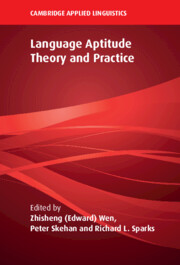Book contents
- Language Aptitude Theory and Practice
- The Cambridge Applied Linguistics Series
- Language Aptitude Theory and Practice
- Copyright page
- Contents
- Figures
- Tables
- Editors and Contributors
- Preface and Acknowledgments
- 1 Language Aptitude Research
- Part I Revisiting and Refining Aptitude Tests
- Part II Aptitude Testing of Diverse Groups
- 6 Testing Language Aptitude for Chinese Learners of Foreign Languages
- 7 Testing Language Aptitude for Recently Arrived Parent–Child Immigrant Dyads
- 8 Is Language Aptitude Immune to Experience?
- 9 Testing Language Aptitude
- Part III Innovative Perspectives and Paradigms
- Part IV Aptitude–Treatment Interaction (ATI)
- Part V Final Commentaries
- Index
- References
6 - Testing Language Aptitude for Chinese Learners of Foreign Languages
FLAT-C vs. LLAMA
from Part II - Aptitude Testing of Diverse Groups
Published online by Cambridge University Press: 27 May 2023
- Language Aptitude Theory and Practice
- The Cambridge Applied Linguistics Series
- Language Aptitude Theory and Practice
- Copyright page
- Contents
- Figures
- Tables
- Editors and Contributors
- Preface and Acknowledgments
- 1 Language Aptitude Research
- Part I Revisiting and Refining Aptitude Tests
- Part II Aptitude Testing of Diverse Groups
- 6 Testing Language Aptitude for Chinese Learners of Foreign Languages
- 7 Testing Language Aptitude for Recently Arrived Parent–Child Immigrant Dyads
- 8 Is Language Aptitude Immune to Experience?
- 9 Testing Language Aptitude
- Part III Innovative Perspectives and Paradigms
- Part IV Aptitude–Treatment Interaction (ATI)
- Part V Final Commentaries
- Index
- References
Summary
The current study explored the concurrent and criterion-related validity of the Foreign Language Aptitude Test for Chinese Learners of Foreign Languages (FLAT-C) with LLAMA as the aptitude test external criterion, and the final-term English test as the criterion regarding achievement. The results show that although the FLAT-C is related to LLAMA, the two language aptitude tests have clear differences; FLAT-C explained 8.5% of the variance in English achievement, which is higher than predictions using LLAMA. The current study provides empirical evidence for the validation of FLAT-C, which is helpful and meaningful to advancing the theory, tests, research, and practice of foreign language aptitude in China.
- Type
- Chapter
- Information
- Language Aptitude Theory and Practice , pp. 119 - 149Publisher: Cambridge University PressPrint publication year: 2023
References
- 1
- Cited by

